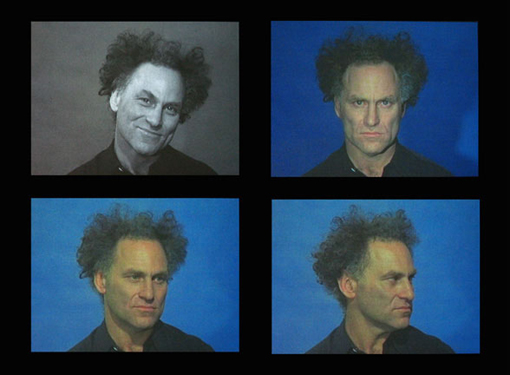

Entering the gallery space one sees a photo of the bust
of a woman from the back in a turtle neck against a coastal
sky. Her posture is static and her presence in the picture
frame is reminiscent of the mute giants in Renee Magritte‘s
paintings. She has a bob styled hair cut.
There is a story to tell about this intriguing picture and its mysterious realism.
Babette Mangolte was commissioned by the legendary concept art magazine Avalanche
to take a portrait of the famous Minimal dance performer Yvonne Rainer for the
cover of the magazine in 1972. Mangolte, at the time, was a photographer and
cinematographer of New York’s downtown scene in dance, performance and
experimental theater; she shared many ideas - intellectual and aesthetic - with
Rainer. Not only did she photograph Rainer’s choreography „Lives
of Performers“ and did act as director of photography of the film that
Rainer made of this piece, - Rainer and other artists she cooperated with, performed
in Mangolte’s first feature film "What Maisie Knew“ (shot in
1973-1974). This photo of Yvonne Rainer’s back is a unique fusion between
Mangolte’s own approach to experimental montage and Rainer’s style
of performance. Rainer often turned her back to the audience or shattered her
face with grotesque gestures that obscure conventional identity representation.
Oddly unfaithful to its editorial charter, Avalanche rejected Mangolte’s
portrait of Rainer in favor of a fairly conventional frontal portrait of the
dancer.
SPACES TO SEE, STORIES TO TELL is Babette Mangolte’s
first solo show in the US. Her work is widely known within
the context of institutional shows on New York performance
art history of the 1970s and from her own film making.
In the 1960s she studied cinematography and film editing
in Paris and came to New York in 1970. She soon started
to take part in the Soho art scene, working closely with
Yvonne Rainer, Trisha Brown, Robert Wilson, Richard Foreman,
Robert Whitman and others, creating one of the most important
bodies of work on performance photography and film.
"What Maisie Knew“ (Collection Centre Pompidou)
was followed by the experimental short film "(NOW)“ and
Mangolte‘s second feature "THE CAMERA: JE, LA
CAMERA: I“ (Collection of MOMA, NY), which will be
screened at BROADWAY 1602 the day after the opening. In
1978 she directed "Watermotor“ based on Trisha
Brown’s groundbreaking dance solo. It remains an
influential film on dance performance of the 1970s. Her
most recent film "Seven Easy Pieces by Marina Abramovic“ premiered
at the Berlin Film festival in February 2007. SPACES TO
SEE, STORIES TO TELL is the first show to fully focus on
Babette Mangolte’s own aesthetic trajectories. We
see formative aspects of the way of life she shared with
artists she cooperated with. There are photographs of her
loft in Tribecca where she still lives - a typical space,
sparsly furnished, almost empty, an inspiring space so
characteristic of the time. These 1970s loft spaces appeared
as film settings for performances that could be staged
at any times. Those bare spaces reflected the motto of
the times that art is life and vice versa.
Film stills from "What Maisie knew“ are all
investigation of spaces and how light invades space. A
door ajar let you peak at Yvonne Rainer and Phillip Glass
in a scene of conceptualized intimacy. Some ritual goes
on on top of a West Side roof. Fog is filling a loft with
the sun pouring in. Exploring photography in her film "THE
CAMERA: JE, LA CAMERA: I“, Mangolte concentrated
on the details of facial expressions in portrait photography
and analyzed the schizophrenic relationship between Mangolte’s aleatory
camera in photography and her conceptual work in film. In the course of this
examination of portraiture, Mangolte filmed a session with Richard Serra not
included in the final edit of the film in 1977. This footage titled „Richard
Serra, Film Portrait“, will be shown for the first time in the gallery.
Serra, now a monument of neo-avant-garde history, poses in front of the camera
with the grandeur of a trained actor. He keeps control over his image up to
the point where he suddenly abandons the pose in an unexpected way.
As part of the preparation in 1977 for "THE CAMERA:
JE, LA CAMERA: I“, Babette Mangolte took many photographs
of Tribeca building facades. In 1978 she manipulated the
images into handmade photomontages by flipping and twisting
these architectural details of facades to form what she
called "Composite Buildings“. This project generated
a body of work of about 90 photomontages in a renewed constructivist
style, portraying the city in its imposing as well as run
down and dark aspects.
Anke Kempkes
The
show was reviewed by Brian Sholis in Artforum,
October 2007
|